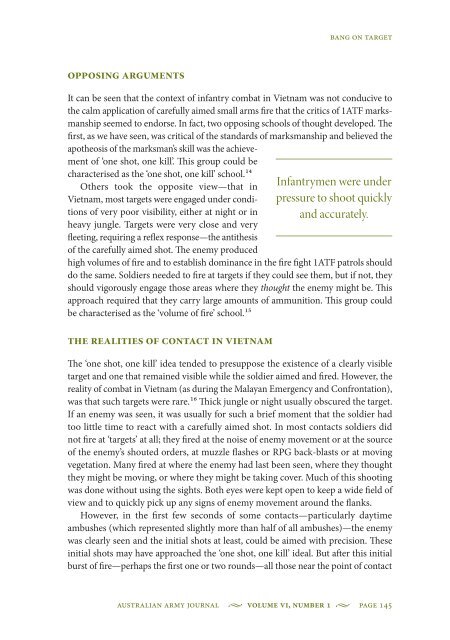Infantry Marksmanship and Combat Effectiveness ... - Australian Army
Infantry Marksmanship and Combat Effectiveness ... - Australian Army
Infantry Marksmanship and Combat Effectiveness ... - Australian Army
You also want an ePaper? Increase the reach of your titles
YUMPU automatically turns print PDFs into web optimized ePapers that Google loves.
Bang on target<br />
Opposing arguments<br />
It can be seen that the context of infantry combat in Vietnam was not conducive to<br />
the calm application of carefully aimed small arms fire that the critics of 1ATF marksmanship<br />
seemed to endorse. In fact, two opposing schools of thought developed. The<br />
first, as we have seen, was critical of the st<strong>and</strong>ards of marksmanship <strong>and</strong> believed the<br />
apotheosis of the marksman’s skill was the achievement<br />
of ‘one shot, one kill’. This group could be<br />
characterised as the ‘one shot, one kill’ school. 14<br />
Others took the opposite view—that in<br />
Vietnam, most targets were engaged under conditions<br />
of very poor visibility, either at night or in<br />
heavy jungle. Targets were very close <strong>and</strong> very<br />
fleeting, requiring a reflex response—the antithesis<br />
of the carefully aimed shot. The enemy produced<br />
high volumes of fire <strong>and</strong> to establish dominance in the fire fight 1ATF patrols should<br />
do the same. Soldiers needed to fire at targets if they could see them, but if not, they<br />
should vigorously engage those areas where they thought the enemy might be. This<br />
approach required that they carry large amounts of ammunition. This group could<br />
be characterised as the ‘volume of fire’ school. 15<br />
The realities of contact in Vietnam<br />
<strong>Infantry</strong>men were under<br />
pressure to shoot quickly<br />
<strong>and</strong> accurately.<br />
The ‘one shot, one kill’ idea tended to presuppose the existence of a clearly visible<br />
target <strong>and</strong> one that remained visible while the soldier aimed <strong>and</strong> fired. However, the<br />
reality of combat in Vietnam (as during the Malayan Emergency <strong>and</strong> Confrontation),<br />
was that such targets were rare. 16 Thick jungle or night usually obscured the target.<br />
If an enemy was seen, it was usually for such a brief moment that the soldier had<br />
too little time to react with a carefully aimed shot. In most contacts soldiers did<br />
not fire at ‘targets’ at all; they fired at the noise of enemy movement or at the source<br />
of the enemy’s shouted orders, at muzzle flashes or RPG back-blasts or at moving<br />
vegetation. Many fired at where the enemy had last been seen, where they thought<br />
they might be moving, or where they might be taking cover. Much of this shooting<br />
was done without using the sights. Both eyes were kept open to keep a wide field of<br />
view <strong>and</strong> to quickly pick up any signs of enemy movement around the flanks.<br />
However, in the first few seconds of some contacts—particularly daytime<br />
ambushes (which represented slightly more than half of all ambushes)—the enemy<br />
was clearly seen <strong>and</strong> the initial shots at least, could be aimed with precision. These<br />
initial shots may have approached the ‘one shot, one kill’ ideal. But after this initial<br />
burst of fire—perhaps the first one or two rounds—all those near the point of contact<br />
<strong>Australian</strong> <strong>Army</strong> Journal • Volume VI, Number 1 • page 145

















